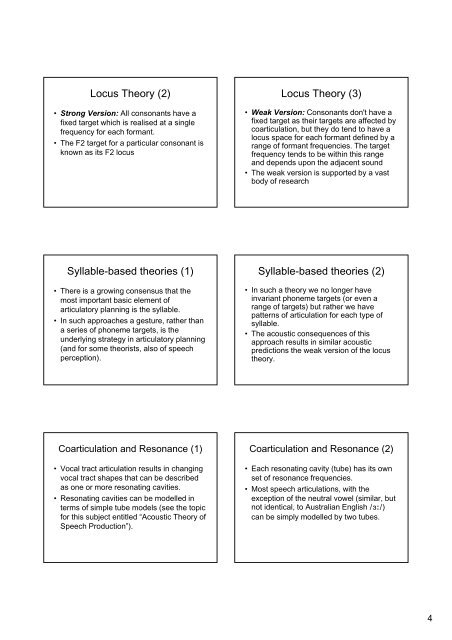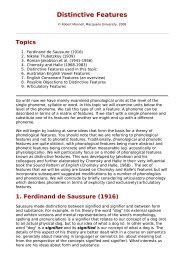PDF version of Lecture Slides - Speech Resource Pages ...
PDF version of Lecture Slides - Speech Resource Pages ...
PDF version of Lecture Slides - Speech Resource Pages ...
Create successful ePaper yourself
Turn your PDF publications into a flip-book with our unique Google optimized e-Paper software.
Locus Theory (2)<br />
• Strong Version: All consonants have a<br />
fixed target which is realised at a single<br />
frequency for each formant.<br />
• The F2 target for a particular consonant is<br />
known as its F2 locus<br />
Syllable-based theories (1)<br />
• There is a growing consensus that the<br />
most important basic element <strong>of</strong><br />
articulatory planning is the syllable.<br />
• In such approaches a gesture, rather than<br />
a series <strong>of</strong> phoneme targets, is the<br />
underlying strategy in articulatory planning<br />
(and for some theorists, also <strong>of</strong> speech<br />
perception).<br />
Coarticulation and Resonance (1)<br />
• Vocal tract articulation results in changing<br />
vocal tract shapes that can be described<br />
as one or more resonating cavities.<br />
• Resonating cavities can be modelled in<br />
terms <strong>of</strong> simple tube models (see the topic<br />
for this subject entitled “Acoustic Theory <strong>of</strong><br />
<strong>Speech</strong> Production”).<br />
Locus Theory (3)<br />
• Weak Version: Consonants don't have a<br />
fixed target as their targets are affected by<br />
coarticulation, but they do tend to have a<br />
locus space for each formant defined by a<br />
range <strong>of</strong> formant frequencies. The target<br />
frequency tends to be within this range<br />
and depends upon the adjacent sound<br />
• The weak <strong>version</strong> is supported by a vast<br />
body <strong>of</strong> research<br />
Syllable-based theories (2)<br />
• In such a theory we no longer have<br />
invariant phoneme targets (or even a<br />
range <strong>of</strong> targets) but rather we have<br />
patterns <strong>of</strong> articulation for each type <strong>of</strong><br />
syllable.<br />
• The acoustic consequences <strong>of</strong> this<br />
approach results in similar acoustic<br />
predictions the weak <strong>version</strong> <strong>of</strong> the locus<br />
theory.<br />
Coarticulation and Resonance (2)<br />
• Each resonating cavity (tube) has its own<br />
set <strong>of</strong> resonance frequencies.<br />
• Most speech articulations, with the<br />
exception <strong>of</strong> the neutral vowel (similar, but<br />
not identical, to Australian English /3:/)<br />
can be simply modelled by two tubes.<br />
4
















